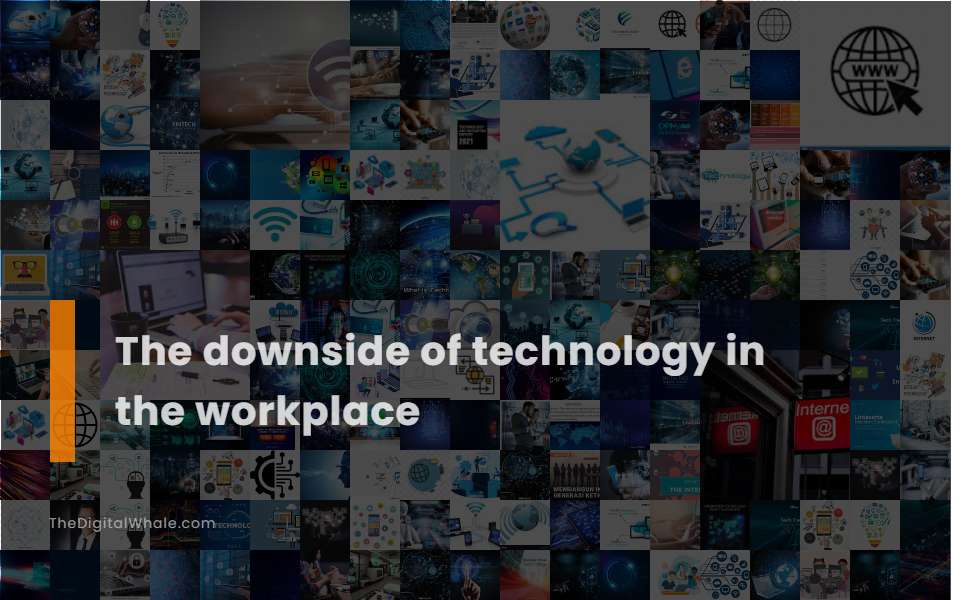The Downside of Technology In the Workplace
What are some disadvantages of technology in the workplace? What are some disadvantages of using technology in the workplace? Let's find out more about The Downside of Technology In the Workplace.

Information overload and stress from excessive communication platforms
Digital communication overload in the workplace leads to significant stress and burnout, with many employees experiencing high anxiety due to the constant stream of online messages, notifications, and the pressure of being always available. This issue particularly affects remote and hybrid workers. For more insights on this, visit the informative article on Digital Communication Overload from Brosix. Addressing these challenges is crucial to maintaining workplace productivity and employee well-being.
Constant notifications and distractions impacting focus and productivity
In today's digital age, constant notifications and distractions from gadgets and social media have become a significant hindrance to focus and productivity. On average, workers are losing about 2.1 hours per day, amounting to a staggering 10.5 hours each week due to these distractions. The prevalence of digital workplace tools like email, instant messaging, and social media contributes to frequent interruptions, notably with workers being distracted almost 14 times daily. This not only decreases productivity but also negatively impacts well-being. Moreover, the disruption of the flow state at work due to multiple web pages and incessant emails causes stress and frustration. Interestingly, while employees often try to compensate for these interruptions by working faster, the result is an increase in fatigue and anxiety. Explore more about the concept of a Distraction Epidemic, which delves deeper into these impacts and the hours lost weekly to such disruptions.
Blurred lines between work and personal life leading to fatigue and burnout
The growing integration of technology in the workplace has significantly blurred the lines between work and personal life, leading to an increase in fatigue and burnout among IT workers. These workers often feel pressured to remain always available and responsive, even beyond traditional work hours. According to the CIO, the everyday use of workplace technologies, such as collaboration tools and messaging apps, further contributes to employee stress by making it difficult for them to disconnect from work. This relentless connectivity creates an "always-on" work culture, which blurs work-life boundaries and exacerbates the risk of burnout.
Increased work hours due to constant connectivity beyond office hours
Constant connectivity to digital technology in the workplace has significant implications for employee well-being, as it often blurs the boundary between work and personal life. This increased work demand extends beyond traditional office hours, often eroding essential work-life balance and leading to mental and physical techno-strain. The [constant connectivity](https://phys.org/news/2024-12-digital-hyperconnectivity-employee-techno-strain.html) compels employees to be perpetually available, exacerbating stress levels and impairing overall productivity. This digital hyperconnectivity extends its reach even into weekends or sick days, creating a sense of obligation to remain engaged with work tasks despite personal circumstances. Such relentless availability and the encroachment on personal time highlight the urgent need for policies that protect employee boundaries, ultimately fostering a healthier and more balancing work environment.
Video conference fatigue and mental exhaustion from remote work
Videoconferencing fatigue, often referred to as "Zoom fatigue," is a state of exhaustion resulting from numerous video calls, characterized by symptoms such as eye strain, forgetfulness, difficulty concentrating, irritability, and general tiredness, which can overlap with burnout symptoms and negatively impact mental and physical well-being. Remote work, particularly during the COVID-19 pandemic, has led to increased mental exhaustion and burnout due to factors like social isolation, excessive workload, and lack of organizational support. This results in emotional exhaustion, reduced productivity, and negative impacts on mental health and work engagement. Understanding how Videoconferencing Fatigue plays a role in this dynamic is crucial for individuals and organizations aiming to foster a healthier work environment.
Related:
What are the best ways to use technology for job search? What are some effective ways to use technology more effectively in your job search? Let's find out more about What Are the Best Ways To Job Search Using Technology?.
Dehumanization of communication through digital tools
In today's evolving workplace, the proliferation of technology can significantly alter the nature of communication, often leading to dehumanization. As tools such as emailing, texting, and instant messaging introduce a layer of anonymity, they can inadvertently encourage behaviors that are antagonistic or exclusionary, replacing genuine social connections with more superficial interactions. Furthermore, the overwhelming presence of technology is shown to increase distractions and lessen face-to-face interactions, contributing to societal issues such as anxiety, depression, and a reduction in empathy and independent thinking. This shift highlights the potential consequences on The Dehumanizing Effect of Technology in communication within professional settings, emphasizing the need for mindful integration of these tools to maintain a balanced and empathetic human connection.
Job elimination and displacement of workers due to automation
Automation in the workplace is projected to eliminate millions of jobs, particularly in sectors such as manufacturing, retail, and healthcare, while simultaneously creating new opportunities. However, this shift often results in significant labor market inequality and displacement for workers unable to adapt to advanced technologies. Estimates suggest that between 75 and 375 million workers globally could lose their jobs to automation by 2030, with high-risk jobs including those in service and manufacturing industries involving repetitive and skill-wise undemanding work. Despite these challenges, automation is expected to foster new job opportunities. For more insights into these dynamics, visit the Understanding the Impact of Automation on Workers Jobs and Wages for a thorough analysis of these trends and their implications on the global workforce.
Surveillance and privacy concerns from monitoring of phone and Internet use
The monitoring of phone and Internet use in the workplace raises significant privacy concerns, as workers may have no control over how their personal information is used, and this data can impact their earnings, access to credit, and other aspects of their lives. Workplace monitoring of these activities must balance business interests with employees' reasonable expectations of privacy. It is crucial to disclose surveillance to employees to avoid invasion-of-privacy lawsuits and maintain trust in the workforce. For more insights on managing surveillance and its implications, visit the Consumer Finance Protection site to understand the potential privacy harms associated with worker surveillance.
Data security threats from hacking and electronic platform vulnerabilities
Data security threats in the workplace are becoming increasingly sophisticated, with social engineering attacks, ransomware, and the rise of AI-powered and quantum computing-based attacks posing significant challenges. These threats can lead to substantial financial losses, legal liabilities, and reputational damage for organizations. Furthermore, the shift to remote work environments has exacerbated these risks, as expanded attack surfaces, unsecured hardware and networks, and vulnerabilities in chat platforms necessitate comprehensive security measures. It's crucial for businesses to stay informed about the latest threats and implement robust security strategies to mitigate these risks. For detailed insights on threats in the technology sector, visit Top Technology Sector Breaches And Threats. Additionally, employee training is essential to fortify defenses against data breaches and cyberattacks.
Greater impatience and diminished trust from reduced face-to-face interactions
Technology in the workplace can lead to greater impatience and diminished trust due to reduced face-to-face interactions, resulting in physical disconnection, increased cognitive load, and diminished employee performance and well-being. For more insights on this, you can visit Negative Impact Technology Business by Deloitte. Understanding these challenges is crucial for developing strategies that nurture healthier communication and trust among employees in a digitally driven environment.
Related:
What are the advantages of using an online resume? What are the four issues that resume no longer work? Let's find out more about Is There A Future for Paper Resumes?.
